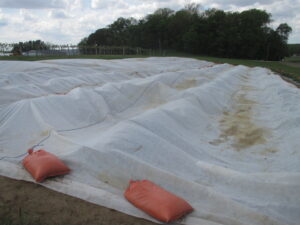Last week when the heavy frost hit us, air temperature at Southwest Purdue Ag Center (SWPAC) in Vincennes, IN dropped to 24°F. We did not take action for frost protection on the strawberries growing with the annual plasticulture system, considering only two early cultivars start to bloom at that time. However, this appears to be a mistake. After a few warm days, flowers grow out on a few other cultivars and they all seem to be damaged. Apparently, the frost not only killed open blooms but also damaged flowers in the popcorn stage. It is important to keep in mind that open strawberry flowers can not tolerate temperatures lower than 30°F, popcorn stage flowers and tight buds may tolerate temperatures low to 26 and 22°F, respectively. Our mistake illustrated the importance of carefully checking the blooming stage of plants in the spring. Even if they have not had open blooms, the spring frost can damage popcorn-stage flowers and cause yield loss. It became apparent that the harvest of early cultivars in our trial will be delayed and yield of some of the cultivars will be reduced significantly. These may include cultivars Radiance, Sensation, San Andreas, Ruby June, and Rocco. Cultivars that have not bloomed in our trial include Chandler, Liz, Camino Real, Galletta, and Flavorfest. They were not affected by last week’s frost in our trial. As more cultivars on the plasticulture system are entering full bloom and early cultivars grown with matted-row system are starting to have open flowers, it became extremely critical for growers to be very careful of any potential frost event in the next a few weeks.
One way to protect strawberry plants from spring frost damage is using floating row covers. Floating row covers have many different weights. Strawberry growers should choose the heavy-weighted ones (1.5 oz/sq. yard or above) in this case. Place the row covers on top of strawberry plants prior to the frost event, and remove them after the frost; adding wire hoops on top of strawberry bed so that the floating row cover is not directly touching the plants will add protection. In a case study last year at SWPAC, we placed 1.5 oz floating row cover on wire hoops in strawberry rows successfully protected flowers as temperature dropped to 24 °F (Figure 1. detailed information about this case study was in this article). Light-weighted row covers (0.5 oz) provide little frost protection. They are more suitable to be used as an insect barrier that covers plants for an extended period of time.
If strawberries are growing in a field without overhead irrigation for frost protection, growers should consider investing in heavy-weighted floating row covers, which can save the crop if there was a heavy frost in the spring. Although we hope not, mother nature may not work the way we hope.

Figure 1. The strawberry field was covered with floating row covers (1.5 oz) for frost protection in the spring.